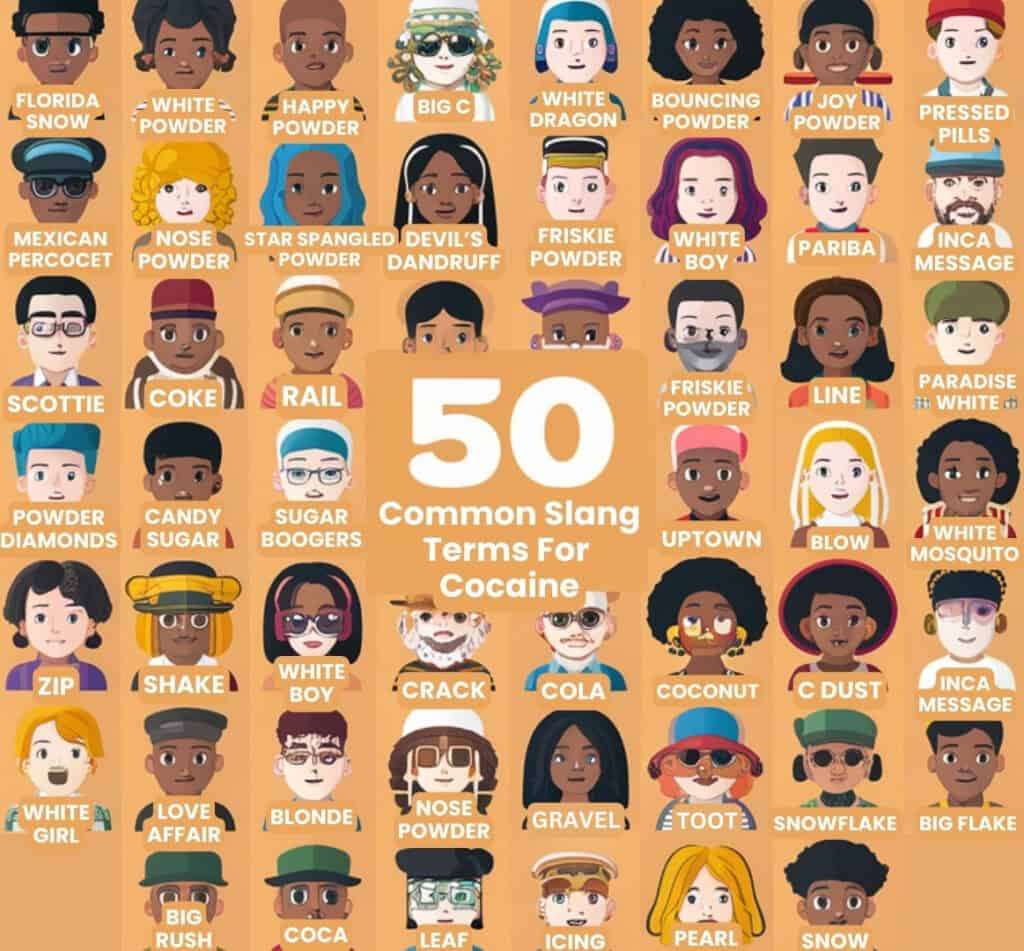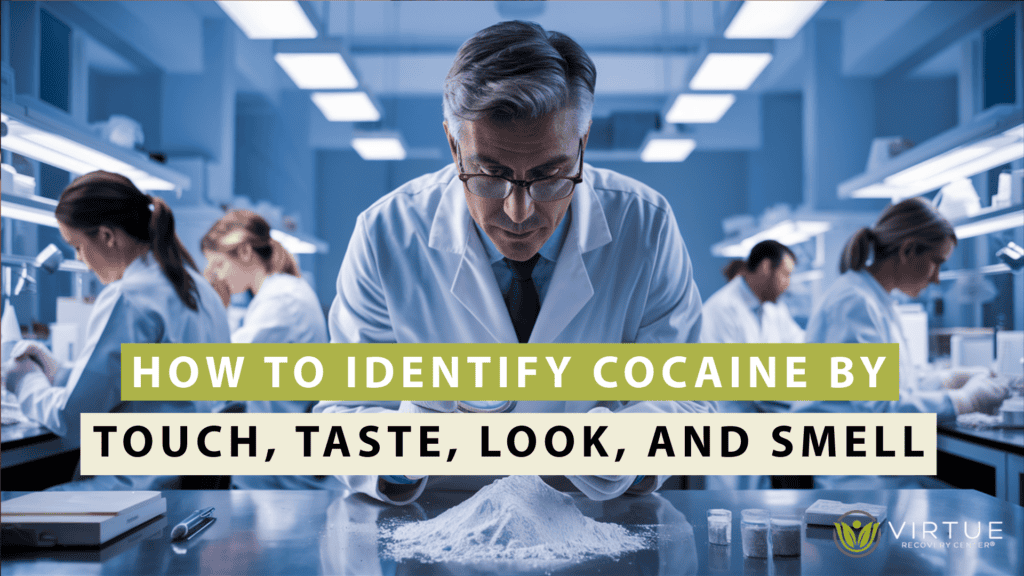Identifying cocaine through the use of sensory systems is an important aspect that may be of great importance to healthcare practitioners and people with an interest in substance use. Cocaine is a powerful stimulant with unique features that can be detected by touch, taste, sight, and smell. This guide will give you more information on these sensory signs and how you can easily detect cocaine and seek cocaine detox and substance abuse treatment.
Key Takeaways
| Aspect | Details |
| Look | White, crystalline powder or off-white, lumpy appearance |
| Touch | Flaky or powdery texture can be slightly damp |
| Taste | Bitter, numbing effect on tongue and gums |
| Smell | Mild, chemical or medicinal odor, sometimes somewhat sweet |
What Is Cocaine?
Cocaine is a powerful and highly addictive stimulant drug derived from the leaves of the coca plant native to South America. It is commonly found in the form of a white, crystalline powder, although it can also be processed into a solid rock crystal known as crack cocaine. Cocaine works by increasing the levels of dopamine, a neurotransmitter associated with pleasure and reward, in the brain. This surge of dopamine creates intense feelings of euphoria, increased energy, and heightened alertness, making it a popular recreational drug.
However, cocaine’s effects on the body and mind are not without significant risks. The drug can cause severe physical and psychological dependence, leading to addiction. Short-term effects of cocaine use include increased heart rate, elevated blood pressure, and hyperstimulation. Long-term use can result in serious health issues such as heart attacks, respiratory failure, strokes, and severe mental health disorders. Due to its high potential for abuse and addiction, cocaine is classified as a Schedule II drug under the Controlled Substances Act in the United States, indicating that it has a high potential for abuse and is available only through a non-refillable prescription. Cocaine has a somewhat short half-life and can stay in your system for a few hours after ingestion.
What Does Cocaine Look Like?
Cocaine is commonly known to be a white crystalline substance, but it can also be off-white and lumpy. This variation in appearance is mainly attributed to the fact that other substances are usually added to the drug to bulk it up and make more money. These cutting agents can be anything from baking soda, talcum powder, or other stimulants. These additives not only change the color and texture of cocaine but also its strength.
Pure cocaine is commonly portrayed as a white crystalline substance with a pearly sheen, which is a sign of its purity. However, when adulterated, it often looks slightly duller and may contain visible impurities or inconsistencies in texture. Cutting agents may also make the substance look less compact and more powdery. It is crucial to identify these visual characteristics. If you come across a substance that has these characteristics, it is likely cocaine.
What Does Cocaine Feel Like?
When touching cocaine, you will notice its flaky or powdery texture. Cocaine can often have a slightly wet feel to it, which is due to its hygroscopic chemistry. This is why cocaine can feel damp to the touch; it draws moisture from the air. When rubbing cocaine between your fingers, it will have a slightly gritty feel to it, like sandpaper. The texture can vary slightly depending on the purity of the cocaine and the presence of any adulterants added to it.
It is important to note these tactile features to determine whether the substance is cocaine or not. For people or those working in places where there is likely to be use of cocaine, it is important to learn about the physical characteristics so it can be easily detected and proper measures taken to assist in the process of elimination. The use of touch in identification, in conjunction with other sensory approaches, improves the capacity to deal with substance abuse issues and risks.
How Does Cocaine Taste?
Cocaine is easily identified by its bitter taste, which is easily discernible as soon as it comes into contact with the taste buds. When a small amount is put on the tongue or gums, it causes a tingling sensation because cocaine is a natural anesthetic. Cocaine inhibits nerve impulses in the area of application and makes the tissues temporarily unresponsive. This effect can be so pronounced that cocaine was once used as a local anesthetic in medical facilities. The bitter taste and the numbing sensation are two of the most important sensory attributes that can be used to identify cocaine.
Cocaine is usually mixed with other substances that may be dangerous or even lethal. Tasting can also result in the consumption of toxic amounts of cocaine. It is crucial to focus on safer and more effective methods of identifying whether a substance is cocaine. For those who are in the field of substance abuse treatment and cocaine detox, it is much safer to rely on professional testing and other physical attributes like the texture and smell of the substance.
What Does Cocaine Smell Like?
The smell of cocaine is not very strong, but it is relatively possible to smell it. Cocaine has a weak chemical or medicinal smell that may be slightly sweet. Most people typically say cocaine has an unpleasant odor. Although the scent may not be very distinct, knowing that this is a common smell associated with the substance can assist in its identification.
The smell of cocaine can vary depending on type and amount. Understanding these sensory characteristics of cocaine is crucial for professionals in substance abuse treatment and individuals who suspect the presence of this drug. Accurately recognizing cocaine can enable timely and appropriate intervention.

50 Common Slang Terms for Cocaine | Virtue Recovery Center – Infographic
Conclusion
In conclusion, recognizing cocaine by its appearance, texture, taste, and smell is crucial for ensuring proper treatment and safety. If you find a substance that matches these descriptions, you must seek professional help immediately. Do not discard the substance by throwing it away or disposing it by flushing it down the toilet. Contact law enforcement if you happen across a substance you believe is cocaine.
Read our new article about Fentanyl and learn about common myths and surprising facts like ‘What does fentanyl taste like?’ and ‘Can you overdose on fentanyl from touching it?‘
Cocaine Addiction & Treatment
If you or a loved one is addicted to cocaine, seeking professional treatment may save a life. Quitting cocaine and enduring withdrawal alone can be challenging, but with the support of the trained medical staff at Virtue Recovery Center, you can overcome addiction. Virtue Recovery is in-network with many insurance providers, which may cover the cost of your cocaine addiction treatment. Verify your insurance to determine if your addiction treatment is covered at Virtue Recovery.
FAQ
Q: What does cocaine look like?
A: Cocaine typically appears as a white, crystalline powder or an off-white, lumpy substance. Pure cocaine has a pearly white color, while adulterated cocaine looks slightly duller.
Q: How does cocaine feel to the touch?
A: Cocaine feels flaky or powdery and may be slightly damp due to its hygroscopic properties. When rubbed between fingers, it feels coarse, similar to fine grains of sand.
Q: What does cocaine taste like?
A: Cocaine has a distinct bitter taste and numbs the tongue and gums due to its anesthetic properties.
Q: How does cocaine smell?
A: Cocaine has a mild, chemical, or medicinal odor, sometimes described as slightly sweet. The smell may not be immediately noticeable, but it can be a clue when you know its typical scent.
Q: What are some common names for powdered cocaine?
A: blow, nose candy, powder, flake, candy sugar, white dragon, shake, soft, and sugar boogers are some popular names used to describe powdered cocaine.
CITATIONS
Cocaine – National Institute on Drug Abuse
https://www.drugabuse.gov/drug-topics/cocaine
Powdered Cocaine Fast Facts – National Drug Intelligence Center
https://www.justice.gov/archive/ndic/pubs3/3951/index.htm
Signs of Cocaine Use and Intoxication – verywellmind.com
https://www.verywellmind.com/signs-of-cocaine-use-addiction-5525536
Cocaine Abuse & Addiction – NYC Health
https://www.nyc.gov/site/doh/health/health-topics/cocaine-abuse-and-addiction.page



























